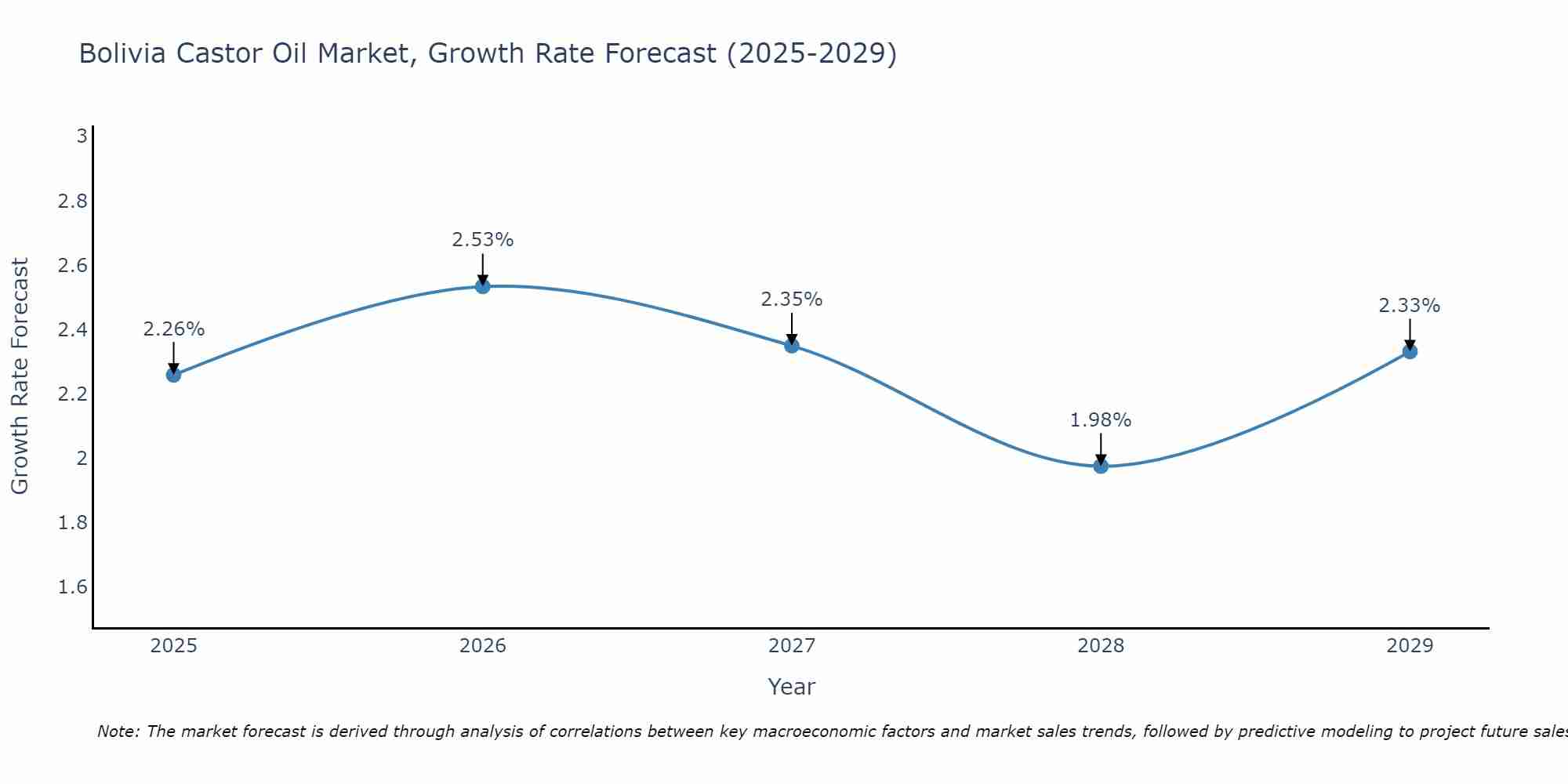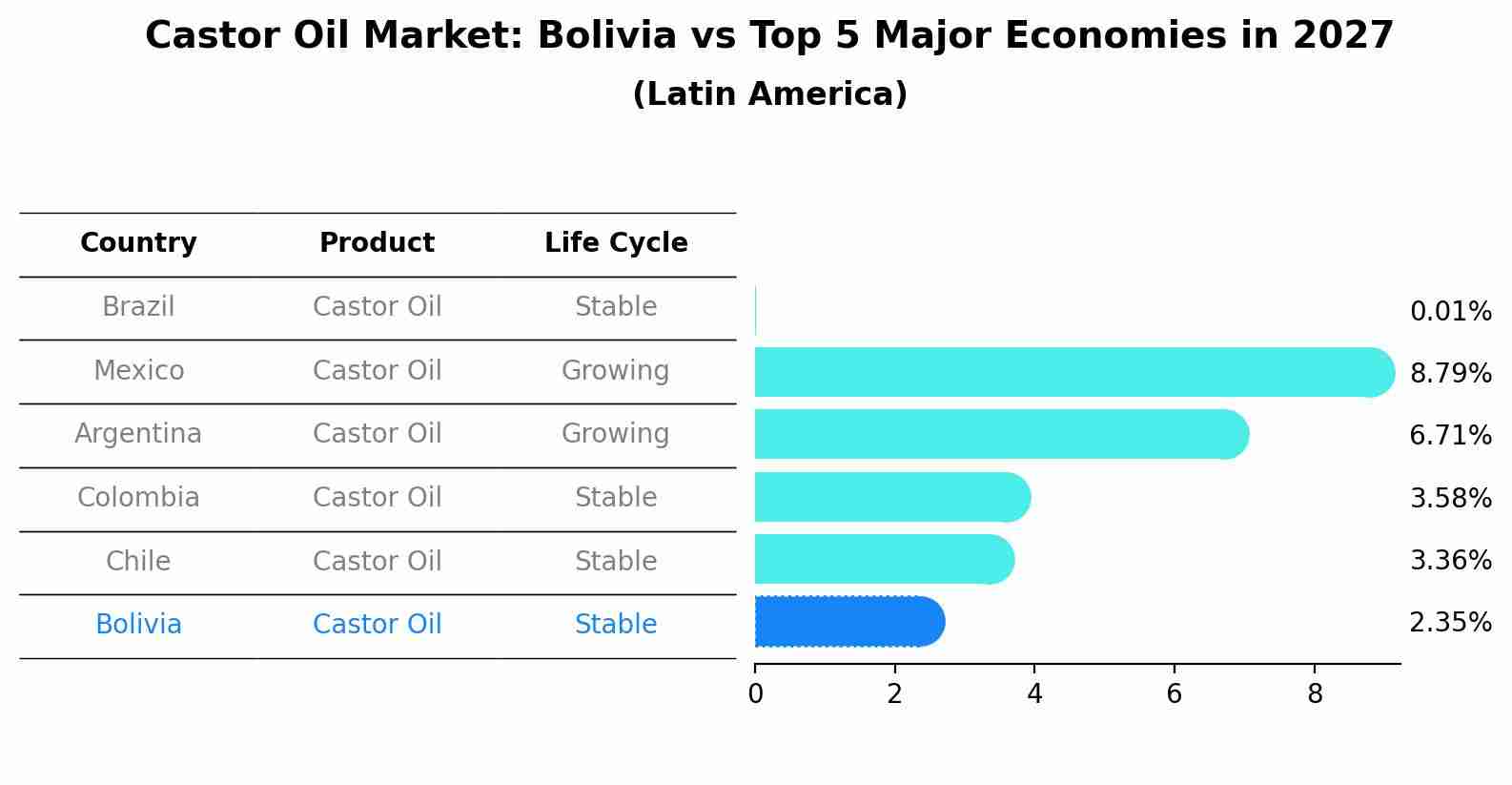Bolivia Castor Oil Market (2025-2031) | Growth, Share, Analysis, Revenue, Outlook, Value, Size, Trends, Industry, Segmentation, Companies & Forecast
| Product Code: ETC5343548 | Publication Date: Nov 2023 | Updated Date: Aug 2025 | Product Type: Market Research Report | |
| Publisher: 6Wresearch | Author: Bhawna Singh | No. of Pages: 60 | No. of Figures: 30 | No. of Tables: 5 |
Bolivia Castor Oil Market Size Growth Rate
The Bolivia Castor Oil Market is projected to witness mixed growth rate patterns during 2025 to 2029. Starting at 2.26% in 2025, the market peaks at 2.53% in 2026, and settles at 2.33% by 2029.

Castor Oil Market: Bolivia vs Top 5 Major Economies in 2027 (Latin America)
The Castor Oil market in Bolivia is projected to grow at a stable growth rate of 2.35% by 2027, within the Latin America region led by Brazil, along with other countries like Mexico, Argentina, Colombia and Chile, collectively shaping a dynamic and evolving market environment driven by innovation and increasing adoption of emerging technologies.

Bolivia Castor Oil Market Overview
Bolivia`s castor oil market is growing, with applications in cosmetics, pharmaceuticals, and industrial sectors. Castor oil is valued for its moisturizing, anti-inflammatory, and chemical properties, driving demand across various industries.
Drivers of the market
The castor oil market in Bolivia is driven by its wide range of applications, including pharmaceuticals, cosmetics, lubricants, and bio-based plastics. The growing demand for natural and sustainable products in various industries further propels market growth.
Challenges of the market
The castor oil market in Bolivia is challenged by fluctuating raw material prices and the need for effective production and processing technologies. Castor oil is used in cosmetics, pharmaceuticals, and industrial applications, but the market must address issues such as supply chain stability, competition from alternative oils, and regulatory compliance.
Government Policy of the market
In Bolivia, the castor oil market is regulated to ensure the safety and quality of the oil for various uses, including pharmaceuticals, cosmetics, and industrial applications. The government implements quality control measures and enforces standards for the production and processing of castor oil. Import regulations are also in place to control the quality of castor oil entering the market. Additionally, Bolivian agricultural policies support the cultivation of castor plants, aiming to boost local production and reduce dependency on imports.
Key Highlights of the Report:
- Bolivia Castor Oil Market Outlook
- Market Size of Bolivia Castor Oil Market, 2024
- Forecast of Bolivia Castor Oil Market, 2031
- Historical Data and Forecast of Bolivia Castor Oil Revenues & Volume for the Period 2021-2031
- Bolivia Castor Oil Market Trend Evolution
- Bolivia Castor Oil Market Drivers and Challenges
- Bolivia Castor Oil Price Trends
- Bolivia Castor Oil Porter`s Five Forces
- Bolivia Castor Oil Industry Life Cycle
- Historical Data and Forecast of Bolivia Castor Oil Market Revenues & Volume By End Use for the Period 2021-2031
- Historical Data and Forecast of Bolivia Castor Oil Market Revenues & Volume By Pharmaceuticals for the Period 2021-2031
- Historical Data and Forecast of Bolivia Castor Oil Market Revenues & Volume By Lubricants for the Period 2021-2031
- Historical Data and Forecast of Bolivia Castor Oil Market Revenues & Volume By Paints for the Period 2021-2031
- Historical Data and Forecast of Bolivia Castor Oil Market Revenues & Volume By Soaps for the Period 2021-2031
- Historical Data and Forecast of Bolivia Castor Oil Market Revenues & Volume By Others for the Period 2021-2031
- Bolivia Castor Oil Import Export Trade Statistics
- Market Opportunity Assessment By End Use
- Bolivia Castor Oil Top Companies Market Share
- Bolivia Castor Oil Competitive Benchmarking By Technical and Operational Parameters
- Bolivia Castor Oil Company Profiles
- Bolivia Castor Oil Key Strategic Recommendations
Frequently Asked Questions About the Market Study (FAQs):
1 Executive Summary |
2 Introduction |
2.1 Key Highlights of the Report |
2.2 Report Description |
2.3 Market Scope & Segmentation |
2.4 Research Methodology |
2.5 Assumptions |
3 Bolivia Castor Oil Market Overview |
3.1 Bolivia Country Macro Economic Indicators |
3.2 Bolivia Castor Oil Market Revenues & Volume, 2021 & 2031F |
3.3 Bolivia Castor Oil Market - Industry Life Cycle |
3.4 Bolivia Castor Oil Market - Porter's Five Forces |
3.5 Bolivia Castor Oil Market Revenues & Volume Share, By End Use, 2021 & 2031F |
4 Bolivia Castor Oil Market Dynamics |
4.1 Impact Analysis |
4.2 Market Drivers |
4.2.1 Increasing awareness about the benefits of castor oil in various industries such as cosmetics, pharmaceuticals, and automotive. |
4.2.2 Growing demand for organic and natural products, with castor oil being a key ingredient in many eco-friendly products. |
4.2.3 Favorable government policies and initiatives to promote the production and export of castor oil. |
4.3 Market Restraints |
4.3.1 Fluctuations in raw material prices, such as castor seeds, can impact the overall production cost and pricing of castor oil. |
4.3.2 Limited availability of skilled labor for castor oil production and processing. |
4.3.3 Environmental challenges such as climate change and pests affecting castor seed cultivation. |
5 Bolivia Castor Oil Market Trends |
6 Bolivia Castor Oil Market Segmentations |
6.1 Bolivia Castor Oil Market, By End Use |
6.1.1 Overview and Analysis |
6.1.2 Bolivia Castor Oil Market Revenues & Volume, By Pharmaceuticals, 2021-2031F |
6.1.3 Bolivia Castor Oil Market Revenues & Volume, By Lubricants, 2021-2031F |
6.1.4 Bolivia Castor Oil Market Revenues & Volume, By Paints, 2021-2031F |
6.1.5 Bolivia Castor Oil Market Revenues & Volume, By Soaps, 2021-2031F |
6.1.6 Bolivia Castor Oil Market Revenues & Volume, By Others, 2021-2031F |
7 Bolivia Castor Oil Market Import-Export Trade Statistics |
7.1 Bolivia Castor Oil Market Export to Major Countries |
7.2 Bolivia Castor Oil Market Imports from Major Countries |
8 Bolivia Castor Oil Market Key Performance Indicators |
8.1 Average yield per hectare of castor seeds, indicating the efficiency of production. |
8.2 Percentage of castor oil produced meeting quality standards, reflecting the product's market competitiveness. |
8.3 Adoption rate of sustainable practices in castor oil production, showing the market's commitment to environmental responsibility. |
9 Bolivia Castor Oil Market - Opportunity Assessment |
9.1 Bolivia Castor Oil Market Opportunity Assessment, By End Use, 2021 & 2031F |
10 Bolivia Castor Oil Market - Competitive Landscape |
10.1 Bolivia Castor Oil Market Revenue Share, By Companies, 2024 |
10.2 Bolivia Castor Oil Market Competitive Benchmarking, By Operating and Technical Parameters |
11 Company Profiles |
12 Recommendations | 13 Disclaimer |
- Single User License$ 1,995
- Department License$ 2,400
- Site License$ 3,120
- Global License$ 3,795
Search
Thought Leadership and Analyst Meet
Our Clients
Related Reports
- Canada Oil and Gas Market (2026-2032) | Share, Segmentation, Value, Industry, Trends, Forecast, Analysis, Size & Revenue, Growth, Competitive Landscape, Outlook, Companies
- Germany Breakfast Food Market (2026-2032) | Industry, Share, Growth, Size, Companies, Value, Analysis, Revenue, Trends, Forecast & Outlook
- Australia Briquette Market (2025-2031) | Growth, Size, Revenue, Forecast, Analysis, Trends, Value, Share, Industry & Companies
- Vietnam System Integrator Market (2025-2031) | Size, Companies, Analysis, Industry, Value, Forecast, Growth, Trends, Revenue & Share
- ASEAN and Thailand Brain Health Supplements Market (2025-2031) | Strategy, Consumer Insights, Analysis, Investment Trends, Opportunities, Growth, Size, Share, Industry, Revenue, Segments, Value, Segmentation, Supply, Forecast, Restraints, Outlook, Competition, Drivers, Trends, Demand, Pricing Analysis, Competitive, Strategic Insights, Companies, Challenges
- ASEAN Bearings Market (2025-2031) | Strategy, Consumer Insights, Analysis, Investment Trends, Opportunities, Growth, Size, Share, Industry, Revenue, Segments, Value, Segmentation, Supply, Forecast, Restraints, Outlook, Competition, Drivers, Trends, Demand, Pricing Analysis, Competitive, Strategic Insights, Companies, Challenges
- Europe Flooring Market (2025-2031) | Outlook, Share, Industry, Trends, Forecast, Companies, Revenue, Size, Analysis, Growth & Value
- Saudi Arabia Manlift Market (2025-2031) | Outlook, Size, Growth, Trends, Companies, Industry, Revenue, Value, Share, Forecast & Analysis
- Uganda Excavator, Crane, and Wheel Loaders Market (2025-2031) | Strategy, Consumer Insights, Analysis, Investment Trends, Opportunities, Growth, Size, Share, Industry, Revenue, Segments, Value, Segmentation, Supply, Forecast, Restraints, Outlook, Competition, Drivers, Trends, Demand, Pricing Analysis, Competitive, Strategic Insights, Companies, Challenges
- Rwanda Excavator, Crane, and Wheel Loaders Market (2025-2031) | Strategy, Consumer Insights, Analysis, Investment Trends, Opportunities, Growth, Size, Share, Industry, Revenue, Segments, Value, Segmentation, Supply, Forecast, Restraints, Outlook, Competition, Drivers, Trends, Demand, Pricing Analysis, Competitive, Strategic Insights, Companies, Challenges
Industry Events and Analyst Meet
Whitepaper
- Middle East & Africa Commercial Security Market Click here to view more.
- Middle East & Africa Fire Safety Systems & Equipment Market Click here to view more.
- GCC Drone Market Click here to view more.
- Middle East Lighting Fixture Market Click here to view more.
- GCC Physical & Perimeter Security Market Click here to view more.
6WResearch In News
- Doha a strategic location for EV manufacturing hub: IPA Qatar
- Demand for luxury TVs surging in the GCC, says Samsung
- Empowering Growth: The Thriving Journey of Bangladesh’s Cable Industry
- Demand for luxury TVs surging in the GCC, says Samsung
- Video call with a traditional healer? Once unthinkable, it’s now common in South Africa
- Intelligent Buildings To Smooth GCC’s Path To Net Zero


















